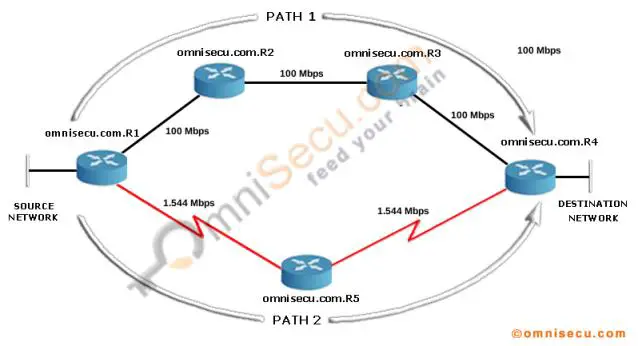EIGRP Metric Calculation Formula with example
Enhanced Interior Gateway Routing Protocol (EIGRP) uses a complex equation to find the Route Metric value.
Enhanced Interior Gateway Routing Protocol (EIGRP) consider the following network performance related attributes to calculate the EIGRP metric value. 1) Bandwidth 2) Delay 3) Reliability and 4) Load
EIGRP Metric = 256*((K1*Bandwidth) + (K2*Bandwidth)/(256-Load) + K3*Delay)*(K5/(Reliability + K4)))
By default, the values of K1 and K3 are set to 1, and K2, K4 and K5 are set to 0.
Hence the above equation is deduced to
EIGRP Metric = 256*(Bandwidth + Delay)
Where
• Bandwidth = 10000000/bandwidth(i), where bandwidth(i) is the least bandwidth of all outgoing interfaces on the route to the destination network represented in kilobits.
• Delay = delay(i)
where delay(i) is the sum of the delays configured on the interfaces, on the route to the
destination network, in tens of microseconds.
Note: If K5 is set to zero, the last part of the EIGRP metric calculation formula (K5/(Reliability + K4)) is taken as 1.
Consider below network topology

Here we have two paths from Source Network to the Destination Network. Along Path 1 we have Fast Ethernet links (Bandwidth 100 Mbps) and along Path 2 we have Serial links (Bandwidth 1.544 Mbps).
The Bandwidth supported by Fastethernet is 100000 Kbit/sec(100 Mbps) and Delay is 100 usec.
The Bandwidth supported by Serial interface in this example is1544 Kbit/sec(1.544 Mbps) and Delay is 20000 usec.
To confirm, run the Cisco IOS show command "show inteface fa0/0" and "show inteface s1/0" from privileged mode.omnisecu.com.R1>enable omnisecu.com.R1#show interfaces fastEthernet 0/0 FastEthernet0/0 is up, line protocol is up Hardware is i82543 (Livengood), address is ca05.08a0.0008 (bia ca05.08a0.0008) Internet address is 192.168.0.1/30 MTU 1500 bytes, BW 100000 Kbit/sec, DLY 100 usec, reliability 255/255, txload 1/255, rxload 1/255 Encapsulation ARPA, loopback not set Keepalive set (10 sec) --More--
omnisecu.com.R1>enable
omnisecu.com.R1#show interfaces serial 1/0
Serial1/0 is up, line protocol is up
Hardware is M8T-X.21
Internet address is 192.168.0.18/30
MTU 1500 bytes, BW 1544 Kbit/sec, DLY 20000 usec,
reliability 255/255, txload 1/255, rxload 1/255
Encapsulation HDLC, crc 16, loopback not set
Keepalive set (10 sec)
--More--
The Metric along Path 1 to the destination network can be calculated as below.
Least Bandwidth = 100 Mbps
Total Delay = 400 usec (100 usec * 4)
EIGRP Metric (Along Path 1) = 256*[(10000000/100000)+(400/10)] = 35840
Run the show command "show ip route" from privileged mode to verify the metric value.
omnisecu.com.R1>enable
omnisecu.com.R1#show ip route
Codes: C - connected, S - static, R - RIP, M - mobile, B - BGP
D - EIGRP, EX - EIGRP external, O - OSPF, IA - OSPF inter area
N1 - OSPF NSSA external type 1, N2 - OSPF NSSA external type 2
E1 - OSPF external type 1, E2 - OSPF external type 2
i - IS-IS, su - IS-IS summary, L1 - IS-IS level-1, L2 - IS-IS level-2
ia - IS-IS inter area, * - candidate default, U - per-user static route
o - ODR, P - periodic downloaded static route
Gateway of last resort is not set
C 172.16.0.0/16 is directly connected, FastEthernet0/1
D 172.27.0.0/16 [90/35840] via 192.168.0.2, 01:24:29, FastEthernet0/0
192.168.0.0/24 is variably subnetted, 6 subnets, 2 masks
D 192.168.0.8/30 [90/33280] via 192.168.0.2, 01:24:29, FastEthernet0/0
D 192.168.0.12/30
[90/2177536] via 192.168.0.2, 01:24:29, FastEthernet0/0
C 192.168.0.0/30 is directly connected, FastEthernet0/0
D 192.168.0.0/24 is a summary, 01:27:11, Null0
D 192.168.0.4/30 [90/30720] via 192.168.0.2, 01:26:31, FastEthernet0/0
C 192.168.0.16/30 is directly connected, Serial1/0
Here the value 35840 indicates the EIGRP metric value to the Destination Network and 90 is the default Administrative Distance of EIGRP.
Note: Routing Information Protocol (RIP) consider only the Distance (as Hop count) from Source Network to Destination Network as RIP Metric to find the best path to the Destination Network. Other factors like Bandwidth of the connecting links, Delay etc are ignored by Routing Information Protocol (RIP) while selecting the best path.